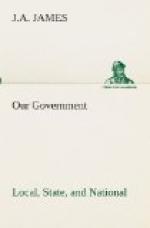Said John Fiske: “Almost everything else in our fundamental institutions was brought by our forefathers in a more or less highly developed condition from England; but the development of the written Constitution, with the consequent relation of the courts to the law-making power, has gone on entirely upon American soil.”
Practical Working of the Government.—Conditions soon proved the articles unsatisfactory. The States were almost independent of the central government. There was no separate executive power to enforce, and no judiciary to interpret the laws. The nation was deep in debt, and without means for payment. Paper money of the period was worthless, and debtors were rebellious. Disputes between the various States brought them to the verge of civil war. Each State had its own system of duties and imposts, which led to great confusion in commerce. No important resolution could be passed in Congress without the votes of nine States. No amendment was possible, except by the votes of all the States. Congress became constantly weaker as various members resigned to accept positions under State authority. In that most dangerous period of our history, extending from 1783 to 1788, aptly called the “critical period,” it became constantly more apparent that government under the Articles of Confederation was a failure. Fortunately, in this hour of gloom, there came forward Washington, Hamilton, Madison, and other leaders, who were prepared, if need be, to make compromises, but who were determined to preserve the elements of the union already secured.
* * * * *
SUPPLEMENTARY QUESTIONS AND REFERENCES.
1. How was the stamp act regarded in the different colonies as shown by the addresses made and resolutions offered? Hart, Contemporaries, II, 395-411; Tyler, Patrick Henry (American Statesmen), Chapters 5 and 6.
2. Do you know of other instances in our history where a stamp act has been passed? How was it regarded? In what ways was it different from that of 1765?
3. What was the origin of the committees of correspondence and how did they aid in unification? Sloane, The French War and the Revolution, 161, 162; Hart, Formation of the Union, 57.
4. Analyze the Declaration of Independence, and select from it the causes for the Revolution.
5. Why was the adoption of the Articles of Confederation so long delayed? Hart, Contemporaries, II, 539-543; Fiske, The Critical Period, 93, 95; Walker, The Making of the Nation, 6; Hart, Formation of the Union, 93-95.
6. Read the Articles of Confederation (Appendix B).
(a) How was the Congress composed? (Art. V.) (b) The number necessary for a quorum? (Art. X.) (c) The powers of Congress? (Art. IX.) (d) Powers of the separate States (Art. VIII.)
7. Defects of the Confederation. Hart, Contemporaries, II, 591-603.




